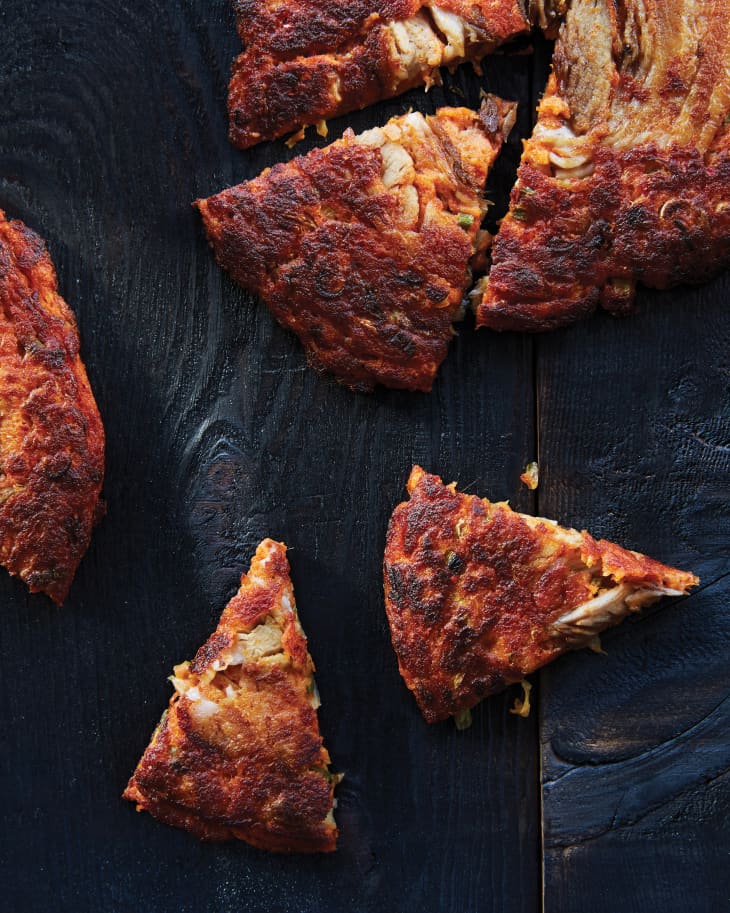Recipe: Bacon and Kimchi Pancakes

Makes4 (7-inch) pancakes
When you hear “pancakes for dinner,” you probably don’t think of bindaettuck, the traditional Korean mung bean pancakes. But while they may require ingredients you haven’t used before, they’re just as quick and easy to make.
At Revel in Seattle, chef Rachel Yang offers ever-changing twists on tradition, from sweet corn pancakes (crusted with corn flakes, natch) in the summer to everything bagel-spiced pancakes with whitefish in the winter. The perennial favorite there, though, and at Revelry in Portland, Oregon, is a funky, spicy, porky pancake — a kimchi-studded classic embedded with strips of braised pork belly.
Served steaming hot from the pan and sliced into fat wedges, it’s a great way to turn a dinner into a party. People reach and giggle and fight over the last piece of earthy pancake, which, in turn, typically leads to someone flagging down a server for round two.
What they don’t tell you at Rachel Yang’s restaurants — and what I learned writing My Rice Bowl: Korean Cooking Outside the Lines with her — is that Korean pancakes make for almost infinitely flexible dinner options, and they’re really quite simple to make. Start with the base, which is just a mixture of soaked mung beans and water that’s been blended until it looks like regular pancake batter with a slightly yellow hue (that’s right — no flour!), then add what you want and fry it up.
I make a quicker version of her pork belly variety by substituting regular bacon for the pork belly, but honestly you should think of the pancakes as a blank slate for any leftovers that aren’t too juicy. Leftover curried squash slices? Throw them in. Shrimp and poblano peppers from last night’s fajitas? Perfect. As Rachel is fond of saying, the easiest Korean dish is the one whose ingredients you already have in the fridge.
I usually soak the beans while I land at home, unpack the day, and have a glass of wine, but you could also make the bean base on the weekend, when you have more time, so you can literally have dinner on the table within 20 minutes. It’s a lot more exciting than Bisquick.
Bacon and Kimchi Pancakes
Makes 4 (7-inch) pancakes
Nutritional Info
Ingredients
For the mung bean base:
- 1 cup
split yellow dried mung beans
- 2 1/2 cups
cold tap water, divided
For the batter:
- 1 cup
loosely packed bean sprouts
- 1 cup
packed coarsely chopped Napa cabbage kimchi
- 4
scallions (white and light-green parts only), chopped
- 2 tablespoons
fish sauce
- 2 tablespoons
coarse Korean chile flakes
- 2
cloves garlic, finely chopped
- 1 teaspoon
kosher salt
For frying:
- 1/2 cup
canola oil, divided, plus more if needed
- 4 slices
bacon or pancetta, halved, cooked through but still soft
Instructions
Soak and blend the mung beans: Place the beans and 2 cups of the water in a medium bowl and soak for 1 hour. They should increase in volume by about 50 percent.
Drain the beans, then place in a high-powered blender or the bowl of a food processor fitted with the blade attachment. Add the remaining 1/2 cup water. Blend on high speed until the mixture is very smooth, 15 to 30 seconds. You can make this mixture and refrigerate, covered, for up to 3 days.
Make the batter: Bring a small saucepan of water to a boil over medium-high heat. Add the bean sprouts and cook for 15 seconds. Drain and transfer to a medium bowl.
Add the blended mung beans, kimchi, scallions, fish sauce, chile flakes, garlic, and salt and stir to combine thoroughly.
Pan-fry the pancakes: Heat an 8-inch nonstick skillet over medium heat. (You can use a regular skillet also; it's just a little more difficult to clean.) Add 1 tablespoon of the oil, and turn the pan to coat the bottom evenly with the oil. Add about 3/4 cup of the batter to the pan and spread into a thin layer 6 or 7 inches in diameter. Place 2 bacon pieces onto the batter and press them in gently. Cook undisturbed until the outer edges of the pancake begin to brown, about 2 minutes.
Using a large spatula, work around the edges of the pancake to loosen it from the pan, then carefully flip the pancake and flatten it gently with the spatula, pressing it down if it bubbles on one side. Drizzle another tablespoon of the oil around the pan and cook until the pancake is golden brown on the second side, 1 to 2 minutes more. Transfer the pancake to a paper towel–lined plate to drain for a moment or two, then serve hot, bacon side up, cut into wedges.
Repeat with the remaining batter, using as much oil as needed each time to keep a 1/8-inch layer on the bottom of the pan, until all the batter has been used. Serve hot.
Recipe Notes
Keeping pancakes warm: If you're going to serve the pancakes immediately after cooking, keep the first pancakes warm in a 300°F oven until serving time.
Make ahead: The mung bean mixture can be made ahead and stored in an airtight container in the refrigerator for up to 3 days. If you'd like to make the batter ahead of time, you can make it up to 24 hours ahead and store in the refrigerator, covered, but add the salt just before frying.
Storage: Leftovers can be stored in an airtight container in the refrigerator for up to 4 days. Reheat in a single layer on a baking sheet in a 400°F oven for 5 to 10 minutes.
Excerpted and adapted from My Rice Bowl by Rachel Yang and Jess Thomson by permission of Sasquatch Books. All rights reserved. (c)2017.
